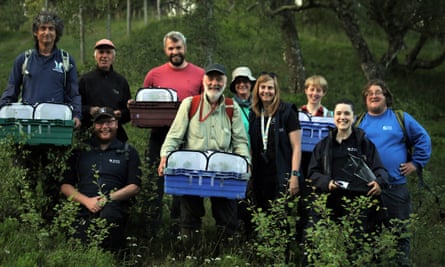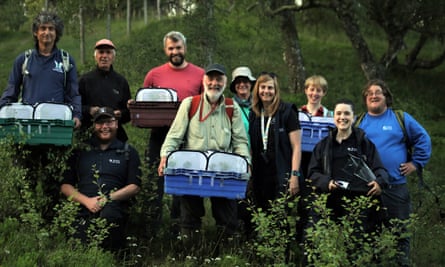A moth on the brink of extinction in Britain and reared for the first time in captivity has been found flying at a site where its caterpillars were released.
The dark bordered beauty is clinging on in just three places in Britain but its numbers are being increased by a conservation project to establish new populations in the Scottish Highlands.
Freshly emerged male moths were last week discovered in non-lethal light traps after 160 caterpillars were released at a secret site in the Cairngorms this summer, raising hopes that the endangered moth can be successfully revived.
The moth, which is virtually extinct in England and only found at two places in the Cairngorms, feeds in Scotland on suckering aspen, a relatively uncommon tree whose young shoots are frequently grazed by livestock or an overabundance of wild deer.
In 2022, 40 dark bordered beauty moth eggs were collected from the wild and transferred to a purpose-built breeding facility at Highland Wildlife Park as the Royal Zoological Society of Scotland (RZSS) in partnership with other conservation charities led the first ever captive breeding programme for the species.

These eggs hatched into caterpillars and then pupated into adults, producing a further 497 eggs. From these, 160 caterpillars were released into the wild.
The first moths from these caterpillars were found in light traps by conservation scientists monitoring the site.
Dr Tom Prescott, the head of conservation for Butterfly Conservation Scotland, said: “I was peering in the moth trap and I could see one on an egg carton in the trap. I couldn’t quite believe my eyes – it was very exciting.
“We hope this is just the start of the moth becoming established at this site – it shows that the habitat is correct, and we hope the population will thrive and become sustainable there.”
Conservation scientists want to spot some female moths at the site during the species’ short flight season of a couple of weeks but the RZSS said “painstaking” captive breeding would continue for some years.
Breeding moths will be carefully paired and managed to maintain their genetic diversity while conservationists also work with landowners to create other suitable sites with lots of young aspen shoots for further releases and to encourage the species – not thought to be particularly mobile – to naturally spread.
Dr Helen Taylor, the conservation programme manager at RZSS, said: “This is a really important and exciting step in our efforts to save dark bordered beauty moths, but there’s still a long way to go.
“We have made a long-term commitment to help improve the conservation status of dark bordered beauty moths and ideally we would like to see successfully reintroduced, self-sustaining populations at multiple sites to safeguard the future of this stunning, but little-known moth. That’s going to take a few years, but this is a brilliant start.”
The moth is one of a number of endangered invertebrates found in the Cairngorms that conservationists are seeking to revive, including the silver stiletto fly, the pine hoverfly and the small scabious mining bee.
Taylor said: “All insects play vital roles in the ecosystems they live in, from pollination to waste recycling. Without these often overlook animals, ecosystems start to fall apart. Working with big, fluffy, charismatic animals is also important, but if we want healthy ecosystems to release animals like beavers and wildcats into, then we need to look after little guys like dark bordered beauty as well. I’m really glad that at RZSS we are working at both ends of that scale.”
Join the exciting world of cryptocurrency trading with ByBit! As a new trader, you can benefit from a $10 bonus and up to $1,000 in rewards when you register using our referral link. With ByBit’s user-friendly platform and advanced trading tools, you can take advantage of cryptocurrency volatility and potentially make significant profits. Don’t miss this opportunity – sign up now and start trading!








Recent Comments